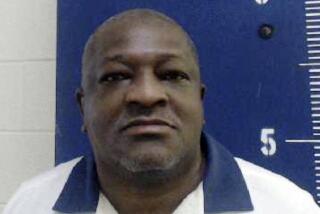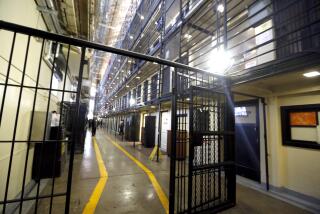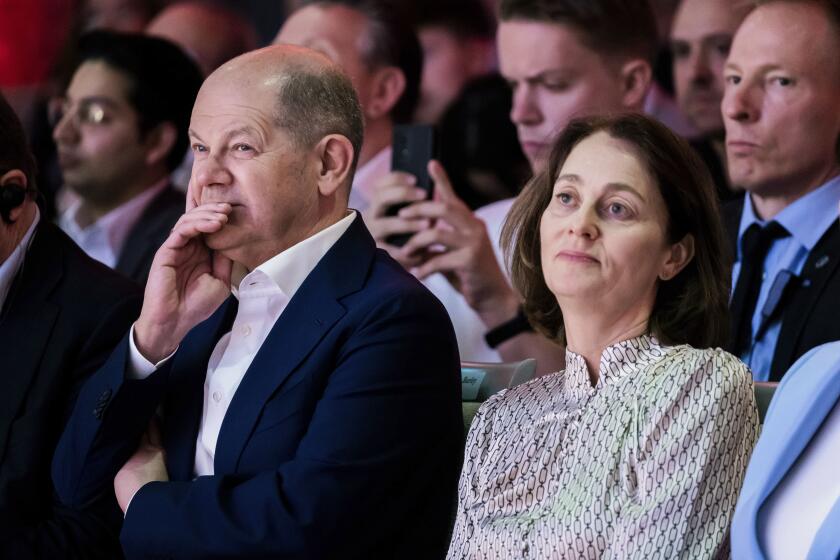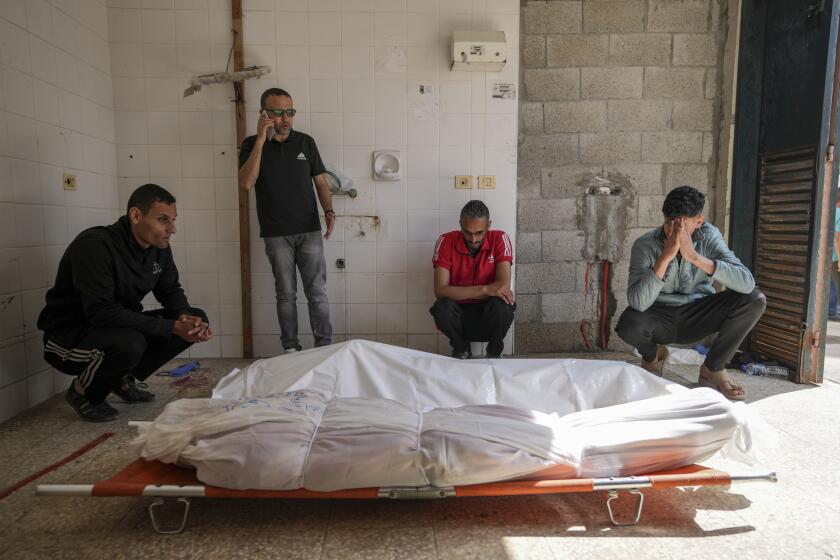Court Grants Harris a Reprieve : Punishment: One stay of execution is lifted by the U.S. Supreme Court. Two others imposed by the 9th Circuit Court postpone the trip to the gas chamber.
Less than six hours before his scheduled execution this morning in the San Quentin gas chamber, murderer Robert Alton Harris won at least a temporary reprieve from a federal appeals court.
After a day of legal maneuvering by attorneys for Harris and the state, the U.S. 9th Circuit Court of Appeals issued a temporary stay of execution at 6:30 p.m. Monday. The purpose of the stay was to give the court’s 28 judges time to vote whether to grant Harris a hearing on his claim that there is new evidence in his case.
That stay was lifted by the U.S. Supreme Court, but a second stay remained in effect. The second stay was imposed by the 9th Circuit shortly after 10 p.m. to allow the judges to be polled on a separate appeal by Harris challenging the legality of executions by gas.
The Supreme Court was said to be considering the case into the night.
After midnight, the prison announced that a third stay of execution had been issued by the 9th Circuit on “the procedural operation of the gas chamber.” The stays had been appealed immediately to the U.S. Supreme Court by aides to state Atty. Gen. Dan Lungren.
Lungren said earlier Monday that the execution, originally scheduled for 12:01 a.m. today, could take place anytime before midnight tonight if the court stays were lifted.
Until the second stay was issued, prison officials had kept to their routine for preparing Harris to die in the gas chamber on schedule. But after the reprieve was announced, state Department of Corrections spokesman Tipton Kindel told news media at the prison that the execution would be delayed.
Gov. Pete Wilson, who had been waiting in his Sacramento office, went home at 11:15 p.m. after it appeared that the execution could be delayed several hours.
Harris was reported to be calm. “He’s subdued right now,” prison spokesman Lt. Vernell Crittendon said after the second stay came down. “I assume he’s optimistic. He’s not openly, not vocally, reacting.”
The unexpected reprieve came shortly after Harris’ last visitors were ordered out of the prison and the double murderer was moved to the “death cell” on the first floor of the prison’s North Block. The cell--which measures 8 by 10 feet--contains only a television, radio, mattress and toilet. It is just 15 paces from the gas chamber and is under constant surveillance by guards.
Earlier in the night, Warden Daniel Vasquez visited Harris for 5 to 10 minutes. At 8:15 p.m. his last meal arrived--two Domino’s pizzas, a 21-piece bucket of Kentucky Fried Chicken and Pepsi. The food was cold, but officials reheated it at the warden’s request.
Harris was given the choice of reading his mail--15 telegrams, some of them with hate messages, according to Crittendon--or eating first. He opted to eat, and bit into the pizza while standing in the dimly lit cell.
Harris’ second cousin, Leon Harris of Mobile, Ala., stood by in an adjacent cell, serving as his spiritual adviser through the night.
Outside the prison, news of the stay drew a cheer from the 400 death penalty protesters gathered on a street of San Quentin Village. The cheer was answered with jeers from about 50 spectators who had come to celebrate the resumption of executions in California after 25 years.
The stays handed down Monday night were procedural moves to provide time for all judges of the 9th Circuit to be polled on a narrow issue--whether to conduct hearings on Harris’ appeals. It takes affirmative votes from 14 judges to convene a hearing. Otherwise, the stays are automatically lifted and the appeals denied.
One of the appeals involves a claim by Harris’ attorneys that his brother Daniel may have fired the first shot in the murders for which Robert was convicted in 1979. The claim was rejected Saturday by a federal judge in San Diego and late Sunday night by a three-judge panel of the 9th Circuit. Harris’ attorneys then asked for further consideration by the full 9th Circuit, which issued the stay rejected by the high court Monday night.
Another remaining issue on appeal before the 9th Circuit was on whether death in the San Quentin gas chamber constitutes cruel and unusual punishment under the U.S. Constitution.
Earlier Monday, Harris said final goodbys to fellow Death Row inmates and several staff members after a 7:30 breakfast. Crittendon said Harris--who seemed “solemn”--wished them well, said “it was nice knowing you” and urged them not to take his death too hard. The other inmates were “rather quiet,” the spokesman said.
San Quentin’s 5,605 prisoners were under lock-down all day Monday and confined to their sleeping areas except to eat.
Meanwhile, a group of designated witnesses to the execution--including relatives of the condemned man’s victims--were guests for dinner Monday night at the home of Warden Vasquez, located on the prison grounds.
Harris’ epochal saga began on July 5, 1978, when he and his brother, Daniel, abducted Michael Baker and John Mayeski, both 16, from a fast-food restaurant’s parking lot in San Diego. After forcing Mayeski and Baker to drive to a rural area, Robert Harris ordered them to walk up a dusty wash and shot them. He was convicted and sentenced to death in 1979.
Harris’ case then embarked on a legal zigzag through state and federal appellate courts. In 1990, he came within 12 hours of an execution but was spared after the U.S. Supreme Court refused to overturn a stay issued by 9th Circuit Judge John T. Noonan.
The latest blizzard of legal papers was launched after Wilson refused to grant clemency for Harris after a hearing in Sacramento last week.
In asking Wilson to spare their client, defense attorneys revisited Harris’ nightmarish childhood to argue that he suffered from fetal alcohol syndrome and thus acted impulsively without regard for consequences. Attorneys also described years of abuse, neglect and torment aimed at Harris by his parents and unearthed reports diagnosing a teen-age Harris as schizophrenic.
Wilson, however, sided with prosecutors, who described Harris as a “psychopath” and pointed out particularly cruel aspects of his crime. Harris, they say, mercilessly ordered one of the teen-agers to “stop crying and die like a man.” After the boys were dead, authorities said the killer nonchalantly ate what remained of their lunch.
The 1978 killings, prosecutors noted, were only the most brutal episode in a life of violence that began when police discovered that Harris was killing cats at age 10.
Early Monday, four relatives of Harris’ victims who traveled to the Bay Area to watch the execution expressed hope it would go forward. Marilyn Clark, the sister of John Mayeski, told CNN she did not want to watch Harris die but believed “this is the only thing we can do to get justice.”
Asked about legal arguments that gassing criminals is cruel and unusual punishment, Clark said: “What Harris did to my brother was cruel and unusual, very unusual. What Harris is getting for the execution is very mild compared to what he did to my brother.”
In Sacramento, Lungren echoed those comments and accused Harris’ attorneys of a “cynical manipulation of our system.”
“Mr. Harris has every right to ensure that his rights are protected,” Lungren told reporters, but added “there has to be some finality . . . there has to be some peace given to the family members (of the victims).”
Before Monday’s night’s repreieve was announced, lawyers for Harris worked feverishly on appeals and tried to fight off a mounting sense of gloom.
By early afternoon, despair had settled over the two defense attorneys who had worked for Harris the longest--Michael J. McCabe and Charles M. Sevilla of San Diego.
“A tremendous injustice is about to be perpetrated in the name of the people of the state of California, and there isn’t a damn thing we can do about it,” McCabe said. Sevilla drove to San Quentin to comfort Harris as the afternoon dragged on.
In Los Angeles, attorney Howard I. Friedman spent much of the day “cross-examining” himself to determine whether any argument was mishandled or ignored on behalf of the condemned man. Friedman, normally a civil lawyer, took time out from his practice to handle Harris’ clemency plea before Wilson.
“I always said I wouldn’t handle criminal cases,” Friedman said. “I didn’t mind being responsible for people’s money, but I didn’t want to be responsible for their liberty. This goes beyond liberty. . . . I was very much aware that I have a man’s life in the palm of my hand. That is very sobering.”
In 1989, Robert Harris told California magazine that his long wait as a condemned man had prepared him for death.
“Over the years, you quit living in a fantasy world. At least, I have,” Harris said. “You learn to face it. I’m ready. If it was my time, I’d walk down there and sit in that chair and say, ‘Let’s do it.’ ”
Those last three words are eerily reminiscent of the phrase uttered by Gary Gilmore of Utah, whose 1977 death by firing squad made him the first man executed in the U.S. after a decade-long hiatus. After a long glance at the cinder-block ceiling of Utah State Prison, Gilmore--who had asked to be executed--told the warden, “Let’s do it.”
The gripping legal drama being played out in recent days echoes the down-to-the-wire battles that often preceded executions when capital punishment was routinely carried out in this state.
One of the most memorable was the back-and-forth duel over the fate of Joseph Francis Regan. Regan got four reprieves from the governor in 1933 during the course of his legal appeals, but the last one came too late. Just as the governor’s clemency secretary was shouting, ‘Stop the execution” over the telephone, the San Quentin hangman let the gallows drop.
Barbara Graham, whose celebrated case became fodder for a Susan Hayward movie called “I Want to Live,” also was granted several last-minute reprieves--including one issued just 90 seconds before she was scheduled to die in 1955. She found them agonizing.
“Why do they torture me?” Graham lamented after she learned of one stay while walking in high heels and stylish dress toward the gas chamber. She returned briefly to her holding cell, then later the same day was executed.
Times staff writers Philip Hager, Richard C. Paddock, Alan Abrahamson and Tom Gorman contributed this story.
* RELATED STORIES: A18, A19
More to Read
Start your day right
Sign up for Essential California for news, features and recommendations from the L.A. Times and beyond in your inbox six days a week.
You may occasionally receive promotional content from the Los Angeles Times.






